Discussing the technical features and marketing strategies of Monad.
Author: Declan Kim, DeSpread
Disclaimer: The content of this report reflects the views of the respective authors, is for reference only, and does not constitute advice to buy or sell tokens or use protocols. Any content in this report does not constitute investment advice and should not be understood as such.
1. Introduction
The importance of the community in the blockchain industry has been repeatedly emphasized. Although the community is often considered a key factor in determining the success or failure of a project, exemplary cases where the community truly contributes to the project, establishes strong bonds among members, and receives appropriate recognition and attention from the team are rare.
In the current market environment with continuous new project releases, attracting the attention of limited market participants and converting them into community members is a challenging first step. Even if the community reaches a certain scale, due to the nature of the market being mainly driven by investment, community activities often rapidly decrease if the token price of the project falls. These situations frequently occur in the relatively short history of the blockchain industry.
The challenges faced in establishing a meaningful community are becoming increasingly severe, and recently, there has been a project with unprecedented community activity, garnering significant attention in the market even before the launch of its test network. This project is Monad, a high-performance Layer 1 blockchain compatible with the Ethereum Virtual Machine (EVM). In this article, we will explore the two main pillars driving the development of Monad: its technology and community, with a particular focus on how Monad is introducing new paradigms to the blockchain industry's community.
2. What is Monad?

Source: Monad
Keone, co-founder and CEO of Monad, previously worked in high-frequency trading (HFT) at the renowned proprietary trading and cryptocurrency company Jump Trading. During his eight years in the traditional finance industry, Keone observed that most blockchains, such as Ethereum, struggle to handle the massive scale required by traditional financial systems, such as executing 2 to 4 million transactions per day and nominal trading volumes exceeding 10 trillion USD. These experiences made him realize that the limited scalability of blockchain is a significant obstacle to its broader adoption. In order to bridge the gap between traditional finance and decentralized finance (DeFi), Keone began to create a network that significantly improves scalability to enable it to process transactions at the scale of traditional finance. This vision laid the foundation for Monad.
As mentioned earlier, Monad's primary goal is to enhance scalability by accelerating transaction processing speed and reducing costs. While several new Layer 1 projects such as Solana, Aptos, and Sei have focused on scalability, Monad stands out by providing full compatibility with the Ethereum Virtual Machine (EVM). This ensures that Monad can fully support Ethereum developers and decentralized applications (dApps), effectively positioning itself as "faster and cheaper Ethereum," distinguishing Monad from Ethereum and other Layer 1 solutions.
3. Monad: Fast and Inexpensive Ethereum
First, let's delve into the technology aspect that has garnered attention for Monad. Two key features are particularly prominent: 1) portability achieved through full EVM compatibility; 2) scalability achieved through Monad's unique consensus and execution architecture.
3.1. Portability: Fully Embracing Ethereum
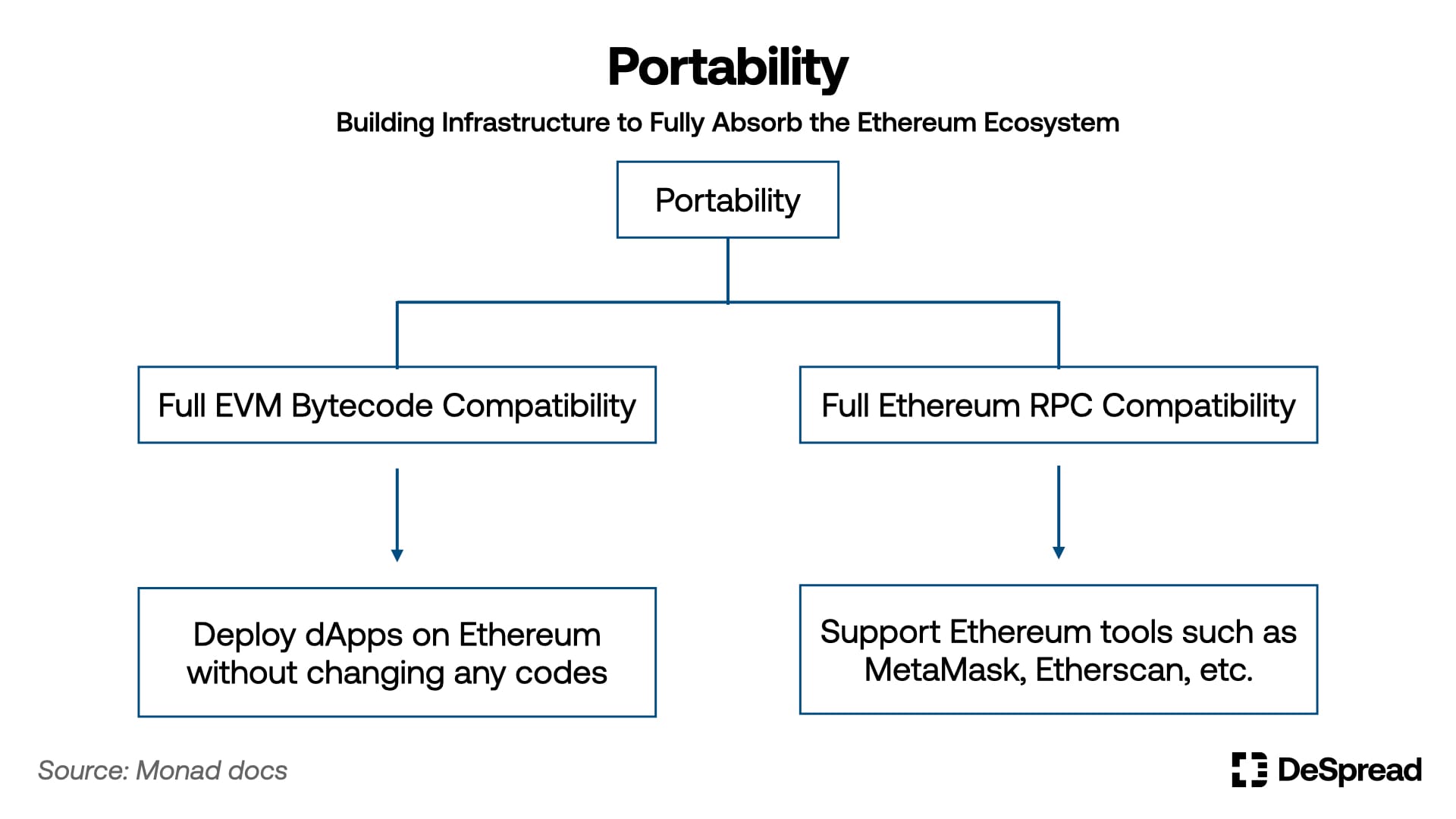
Portability refers to the ability to migrate Ethereum dApp smart contracts to Monad without modifying any code. This feature enables Monad to fully integrate into the Ethereum ecosystem, which has the largest pool of funds and users in the blockchain industry. Monad achieves this portability through two key components:
1) Comprehensive EVM bytecode compatibility and 2) Comprehensive Ethereum RPC compatibility.
3.1.1. Comprehensive EVM Bytecode Compatibility
Bytecode is the format in which the Ethereum Virtual Machine (EVM) stores and executes contracts on the Ethereum network. Smart contracts written in the Solidity programming language must be compiled into bytecode for processing by the EVM.
Monad's EVM bytecode compatibility ensures that any contract deployed on Ethereum can seamlessly migrate to Monad without any modifications. This compatibility enables Monad to accommodate approximately 1,100 dApps currently running on Ethereum. By facilitating seamless migration, Monad significantly addresses the challenges often faced by new blockchain ecosystems, such as attracting popular dApps and their user base, thereby enhancing its competitive position in the market.
3.1.2. Comprehensive Ethereum RPC Compatibility
Ethereum RPC (Remote Procedure Call) is a protocol for communicating with Ethereum nodes, allowing access to data and transaction transmission using the JSON-RPC standard. Full EVM bytecode compatibility enables Monad to directly migrate dApps from Ethereum, while RPC compatibility ensures that various tools for interacting with Ethereum nodes (such as MetaMask, Etherscan, Dune, and Hardhat) can seamlessly operate within the Monad ecosystem.
3.2. Scalability: Achieving 10,000 TPS
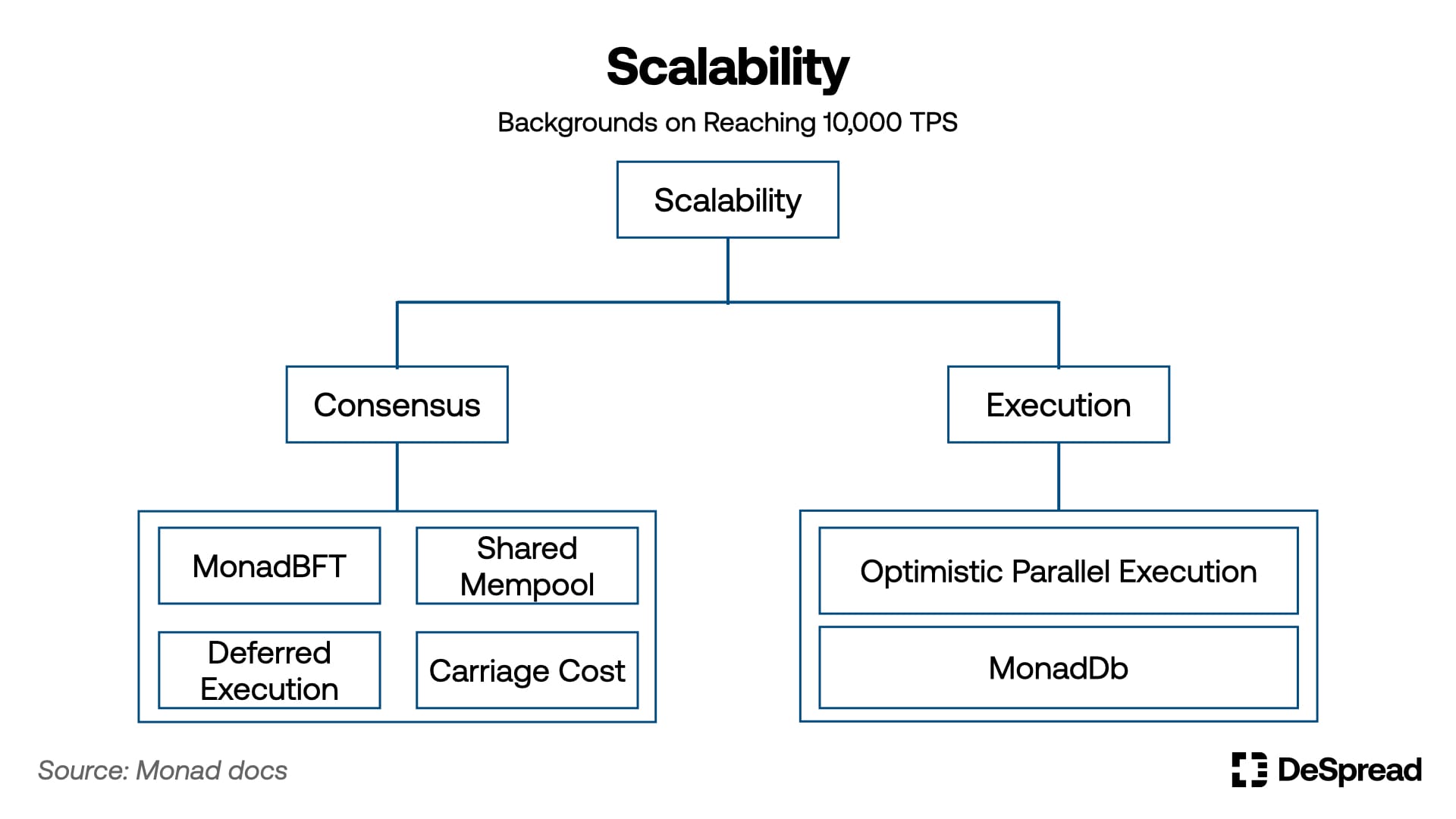
Scalability refers to the network's ability to facilitate rapid transaction processing and maintain low transaction costs. Transactions per second (TPS) is a key metric for evaluating network scalability. On March 14, Monad announced through its official Twitter account that its development network had reached 10,000 TPS. This milestone indicates that Monad has successfully created an environment capable of processing 1 billion transactions per day.
Monad's ability to achieve such high scalability stems from its unique consensus and execution mechanism. In this chapter, we will delve into the core components of Monad's consensus and execution mechanism, which are key to achieving this outstanding performance level.
3.2.1. Consensus
Monad's consensus mechanism consists of four key components:
MonadBFT: This is Monad's unique consensus algorithm, which processes multi-round (non-single round) block proposals, voting, and final results in a pipelined manner.
Shared Mempool: To verify the hash value (unique identifier) of proposed blocks under MonadBFT, each node in Monad shares its Mempool (storage area for pending transactions).
Delayed Execution: Unlike Ethereum's consensus structure, Monad separates consensus and execution, allowing nodes to first agree on transaction order before proceeding with execution.
Transaction Costs and Reserve Balances: This system addresses potential issues caused by insufficient gas fees leading to transaction failures. When users submit transactions, they prepay transportation fees, which are refunded if the transaction is successfully executed. Reserve balances refer to the dedicated balance reserved by each node for paying transaction fees.
3.2.2. Execution
Monad's innovative MonadBFT algorithm separates block consensus from execution, specifically designed to enhance scalability by achieving fast transaction processing and cost reduction. Each part of these four components is carefully designed to complement and support the others to address potential challenges in scalability, such as the shared Mempool to alleviate the issue of nodes only receiving block hash values, and the transaction costs and reserve balance system to address potential gas fee shortages resulting from delayed execution.
Monad's unique execution mechanism revolves around two key elements:
Optimistic Parallel Execution: This mode of operation assumes that all operations are valid, allowing transactions from the next block to be processed in parallel before consensus on the previous block is determined. If any errors are discovered during the validation phase, specific transactions are re-executed. Ultimately, the results of all transactions are linearly ordered, similar to Ethereum.
MonadDb: This custom database stores state information and supports asynchronous input/output operations. This feature allows the system to begin processing the next transaction without waiting for the final determination of the result of the previous transaction.
Monad's approach to improving scalability goes beyond parallel execution. Monad understands that one of the biggest challenges to EVM scalability is the bottleneck caused by state access, and therefore developed its own database, MonadDb, to address this issue. Regardless of how many threads are used for parallel processing, the effectiveness is greatly diminished if the state data in the database cannot be accessed simultaneously.
4. Community: The Alpha and Omega of the Project
Monad's recent surge in popularity is not only due to its fast transaction processing speed, but also the crucial role of its community. While the importance of the community in the blockchain industry has been repeatedly emphasized, few projects have successfully mobilized community members as actively as Monad, especially before the launch of its test network. Monad is a rare example of a community that has been recognized and actively engaged, with the project's official social media accounts and core members of the foundation regularly emphasizing community participation. In this chapter, we will explore the uniqueness of the structure, core values, and growth background of the Monad community.
4.1. Design Direction of the Monad Community
The Monad community is open to everyone, but not all members are treated equally. On its main platforms (Twitter, Telegram, and Discord), Twitter serves as the channel for external brand promotion, while Discord and Telegram differentiate access and activity levels based on members' contributions and length of participation.
In the early stages of community development, Monad faced challenges in promoting active member participation. As a result, Monad created a tiered system to provide different levels of access based on members' contributions. Keone and Kevin elaborated on the principles behind this structure in an interview on the "Good Game Podcast." When Monad's Discord server was launched in October 2022, all participants were given the "Pioneer" role to encourage active participation. However, contrary to expectations, many members who received the role did not remain active. This experience taught Keone and Kevin two important lessons: first, the criteria for role allocation need to be stricter; second, encouraging broader community activities is crucial in addition to simple, repetitive tasks.
In 2023, the announcement of the first round of funding led by DragonFly Capital, totaling $19 million, marked an important turning point in the current structure of the Monad community. At the time, participation in Monad's Discord server was limited, but after the announcement, the demand for participation surged, prompting Monad to open its Discord server to the public. In its place, Monad used private chat rooms to differentiate existing and new community members on Telegram.
Next, we will examine the structure and characteristics of the Monad community on Discord and Telegram.
4.2. Structure of the Monad Community
4.2.1. Discord
In the Monad Discord community, members' access to content and the scope of their activities are determined by the roles they hold. This structure incentivizes community members to engage in various activities to gain roles with higher privileges. The expectation of future rewards, especially after the Token Generation Event (TGE), further fuels this motivation. Although the Monad Foundation has not formally announced role-based rewards, the message from Monad's partner, Wormhole, about airdrops based on member levels, has led participants to expect that Monad will adopt a similar approach in the future.
Activities within the Discord community, such as chatting, daily tasks, and creating memes related to Monad, have been ongoing for a considerable period, helping the project establish a unique identity. Memes such as Molandak, Moyaki, and Chog, which have become synonymous with Monad, were created through the spontaneous efforts of community members. The Monad Foundation has embraced these roles and incorporated them into various brand promotion activities, including creating guilds and producing merchandise.
The following is an overview of the current confirmed roles, their respective privileges, and how they are obtained:
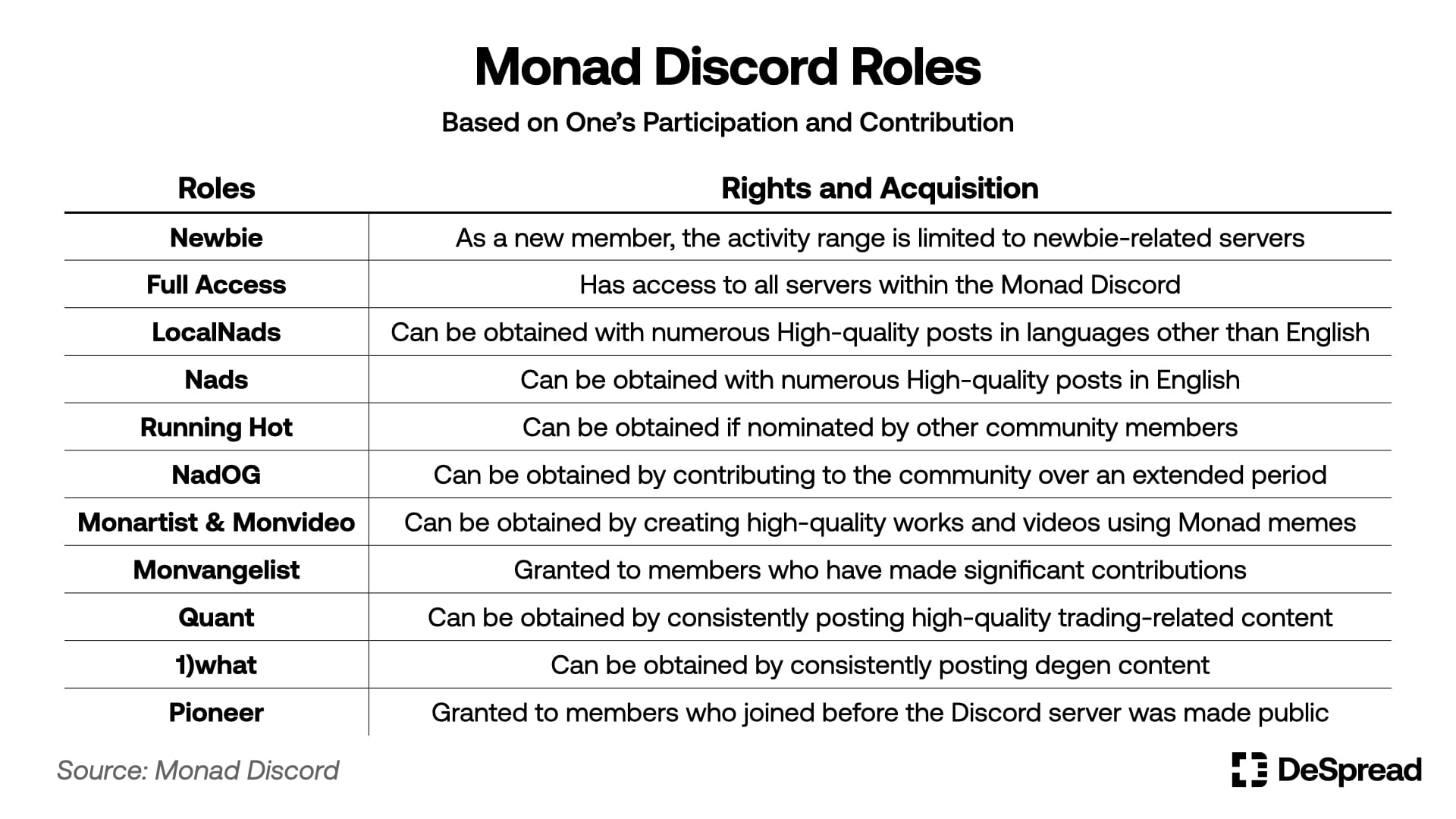
4.2.2. Telegram Community
While the Monad Discord provides an open community space for everyone, Telegram provides a more private environment for members who have made significant contributions to Monad over the long term. There are currently three active chat groups: OG Chat, House of Molandak, and House of Moyaki (formerly known as Purgeatory).
Members who actively participate in online and offline community activities can gain access to the Monad Telegram chat groups, including engaging with the community on Twitter and Discord, participating in various offline gatherings related to Monad, and making significant contributions to brand promotion for Monad. Only those who demonstrate such commitment can receive an invitation link to House of Molandak or House of Moyaki from members with invitation privileges or directly from Monad Foundation members.
Members of the House of Molandak and House of Moyaki chat groups are expected to actively participate in ongoing community activities, including weekly tasks assigned to each group. Members who excel in these tasks (approximately 10 members per chat group) have the opportunity to join the OG chat group each week. However, even in the OG chat room, members must continue to participate in weekly tasks and remain active.
To prevent entry into the private chat groups from becoming the ultimate goal, Monad has implemented a "Thursday Purge Day" system in these three Telegram chat groups. This system clears out 25 to 50 members with extremely low participation every Thursday, reinforcing active member participation and ensuring that only the most dedicated members remain in the chat groups, effectively fostering a culture of sustained and enthusiastic participation.
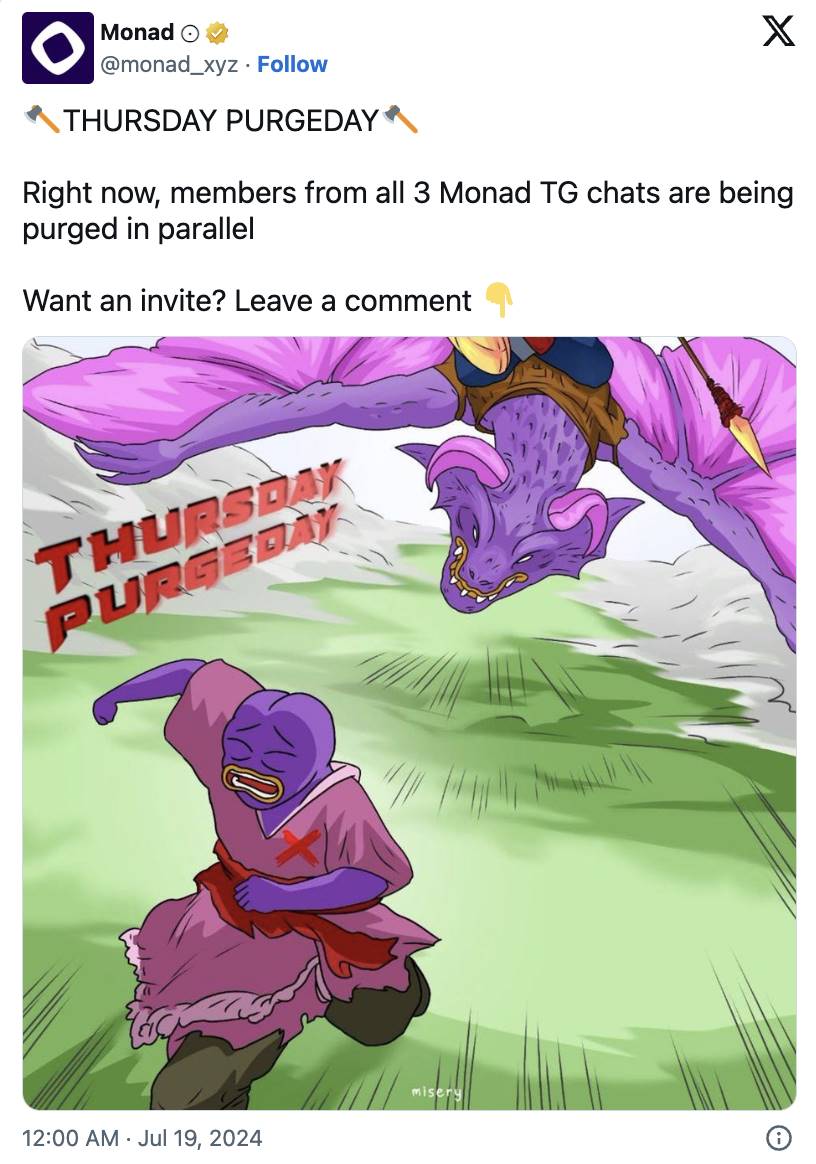
Recently, the private chat group of Monad announced the cessation of weekly tasks, reflecting the foundation's understanding of the fatigue and dissatisfaction felt by community members due to the pressure of continuous participation in activities. The foundation now encourages members to contribute to the community at their own pace and willingness. However, the "Purge Day" continues to be enforced, indicating that the pressure to remain active and engaged has not been completely alleviated.
4.3. Background of Monad Community Development
After exploring the history and characteristics of various channels within the Monad community, we will delve into the strategic push to make the Monad community one of the most renowned in the industry.
4.3.1. Rejecting Playbooks
The so-called "playbook" refers to a set of standard strategies or rules commonly used to achieve certain goals in a specific industry, essentially serving as guiding principles. In the blockchain industry, marketing and community building have traditionally followed established playbooks. This typically includes promoting the project's advantages through social media posts and using platforms like Galxe Quest or Layer3 to attract users and fans through simple tasks such as likes, shares, and quizzes.
However, it has been proven that these methods can effectively boost early project metrics such as followers, Total Value Locked (TVL), and Daily Active Users (DAU). But Monad chose a different path, believing that these superficial metrics do not represent an ideal marketing strategy or community development approach. Therefore, Monad adopted a novel strategy that diverged from industry norms.
From the outset, Monad's primary goal in community building was not just about increasing numbers, but rather focused on creating a lively, fashionable brand image by encouraging community members to engage in humor and meme-based activities on social media. The emphasis was on cultivating a culture where people who see these posts can feel a genuine, voluntary desire to join the community.
Kevin, a key figure in Monad's unique strategy, leads the development work for Monad. Kevin is widely known as "Intern" on Twitter and has introduced a fresh perspective to Web3 marketing. In his article "10 Rules for Cryptocurrency Marketing and Community: A Systematic Design," he outlines these innovative methods.
[Kevin's 10 Rules for Cryptocurrency Marketing]
- Stop posting ads;
- Compete with influential people and entertaining content on Twitter, rather than competing with other protocols;
- Marketing and community strategies should adopt a systematic approach;
- Invest heavily in the community;
- Publish top community content and interact with it through the main account and founder's account;
- Association > Knowledge;
- Do not blindly copy and paste others' strategies;
- Quality > Quantity;
- Do things that are not scalable;
- The community is made up of real people who have real lives and other things to do;
In particular, rules 2 and 6 closely align with the core principles of the attention economy, a concept that has become a mainstream trend in the advertising field of the social media era. The attention economy views human attention as a scarce resource, directly related to a company's value in the industry, and is an important economic method.
Nike emphasizes concepts of freedom, boundlessness, and vitality, rather than the technical advantages of its sneakers; Red Bull emphasizes the spirit of challenge and extreme sports, rather than the caffeine content of its energy drinks. Monad did not prioritize the technical advantages of its product or the size of its investment, but effectively conveyed its brand image through social media, attracting the interest of Web3 users.
4.3.2. Embracing Web3 Native Culture
Rejecting traditional Web3 marketing strategies, Monad chose to embrace Web3 native culture, particularly through the use of memes. In the early stages of establishing the Monad community identity, they adopted the purple version of the Pepe frog, one of the most representative memes in the Web3 space. This character, based on Monad's iconic purple color, was widely shared as Telegram stickers and Twitter memes, ultimately making purple synonymous with the Monad image. As the community developed, members began creating their own memes, giving rise to characters such as Molandak, Moyaki, and Chog. These characters have since become representative memes of Monad.
Under Kevin's leadership, Monad's marketing strategy focused on conveying the project's image through memes in a humorous manner, rather than emphasizing its technical advantages. This approach not only drove explosive growth in the Monad community but also introduced a new trend of the "Intern" account model on social media. The "Intern" account operates separately from the official account on social media, spreading market conditions, project updates, and brand image through memes in a lighthearted and humorous manner.
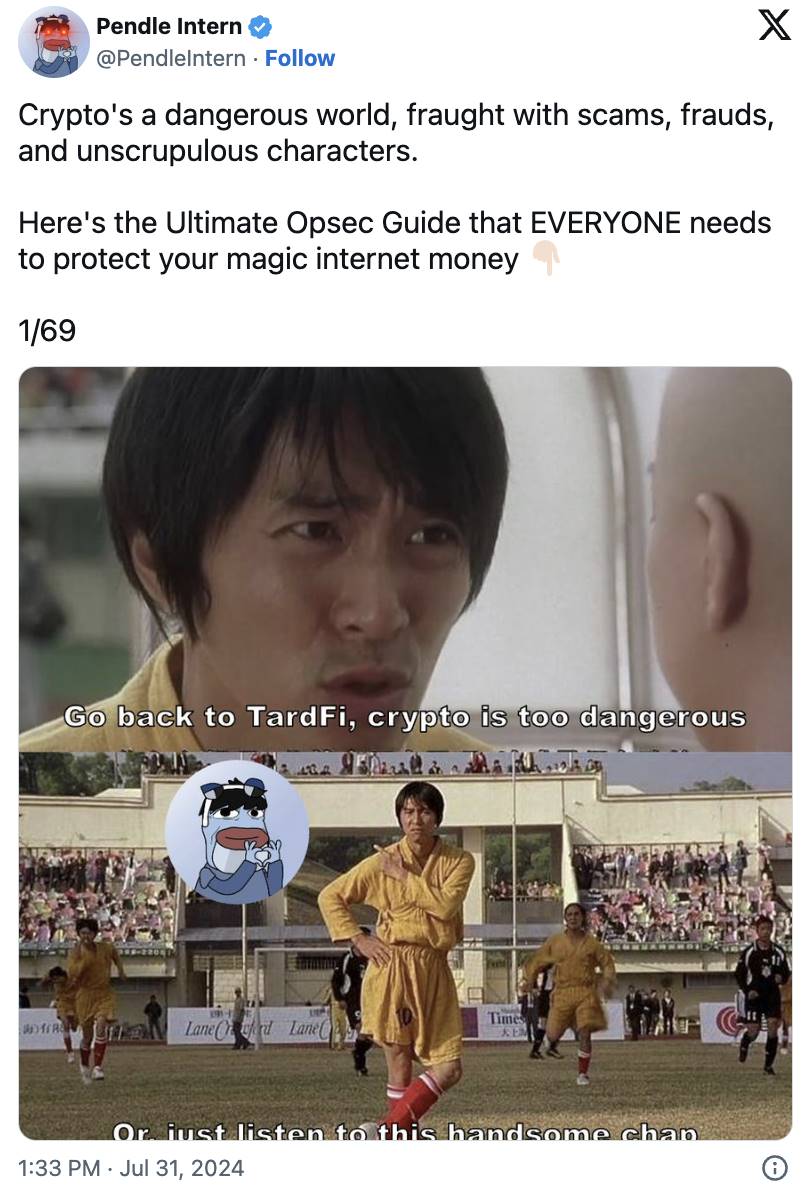
Monad took a proactive approach to recruit influential KOLs on social media, appointing them to key positions in its marketing, ecosystem, and development departments. Influential figures such as Kevin, Threadguy, Tunez, and Bill have joined the Monad team, where they manage community engagement on social media, strengthen brand promotion through meme posting, and collaborate with other projects to expand the ecosystem.
In addition to integrating these KOLs, Monad is also committed to integrating the values of "Monad-ness" throughout the organization, from the foundation to the community. To achieve this goal, Monad has appointed long-time active community members as community managers for their respective countries, and even recruited them as team members. This strategy helps maintain a consistent brand image, foster deeper connections between the community and the project, and ensure that the spirit of Monad is shared and upheld at all levels.
4.3.3. Building a Genuine Community
Bill, the community leader of Monad, believes that the concept of "community" is often misunderstood in the industry. He believes that a true community must be more than just an audience interested in project updates, users engaging with the product, and contributors adding to the code and brand. He believes that a true community is determined by the connections between its members, where people actively interact, exchange ideas, and collectively create new value, such as "Memes." This principle guides the development direction of the Monad community.
The majority of the memes representing Monad are now created by the community rather than the foundation. To this day, a large number of memes created by community members are still being shared and used on various social media platforms such as Discord and Twitter. To promote unity with the community, the foundation also actively participates in these creative activities, including the weekly "Monday Meme" selection, where the foundation highlights the winning memes and their creators through the official account.
In addition to creating memes, the Monad community has expanded its creative work to include video production, physical merchandise creation, and even releasing mixtapes on SoundCloud, all based on Monad's memes. This wide range of activities allows members of the Monad community, even those without blockchain or development expertise, to participate and derive enjoyment from it.
Examples of spontaneous and active participation within the Monad community also include meetups organized by community members in different countries. So far, meetups have been held in multiple countries including Japan, China, and Thailand, and the Seoul meetup held on July 18 in South Korea was notably successful.
5. Conclusion
5.1. Future Challenges
The level of community participation and the quantity of content produced by Monad community members are unprecedented. However, this level of participation also brings increasing pressure and workload to the members.
The structure of the Monad community is differentiated based on members' contributions and their status within the community, through roles in Discord channels and access to private Telegram chat groups. While the foundation has not formally announced it, most participants speculate that Monad may provide different rewards for community members based on these systems at the launch of the mainnet.
To gain more roles and access more groups, community members must complete a series of tasks, including daily and weekly tasks set by Monad, as well as their regular activities on social media. In the process, participants need to demonstrate their creativity and embody the essence of "Monad-ness." Even in highly competitive Telegram chat groups, they need to maintain a high level of activity under the "Purge Day" system. This increasing workload and pressure are directly proportional to the development of the Monad community, leading to criticism from former members about excessive demands within the community and unclear standards for promotion and dismissal.
Furthermore, the importance of retaining users and capital long-term after airdrops has become increasingly evident, as many projects struggle to do so. For the Monad team, maintaining the current level of community engagement after rewards may require a delicate balance between alleviating user fatigue and promoting community development.
5.2. Monad, Setting an Industry Precedent
Monad has become one of the most prominent projects in the cryptocurrency industry, thanks to its unique consensus and execution architecture achieving perfect EVM compatibility and scalability, as well as its innovative community building approach.
The project has introduced unprecedented systems such as private Telegram chat groups, promotion and demotion systems, and community-driven meme creation tasks, garnering significant attention. While these strategies have increased pressure on community members and attracted criticism for the lack of meaningful activities, it is undeniable that Monad emphasizes the crucial importance of the community in the blockchain industry and provides a new example for other projects to reference.
With close market attention, key questions remain: Can the Monad community maintain its vitality and engagement after the mainnet launch? How will rewards for community members be arranged? Will the fully compatible EVM ecosystem of Monad effectively absorb the Ethereum ecosystem and capital? The answers to these questions will be crucial in determining the long-term impact and success of Monad in the blockchain field.
免责声明:本文章仅代表作者个人观点,不代表本平台的立场和观点。本文章仅供信息分享,不构成对任何人的任何投资建议。用户与作者之间的任何争议,与本平台无关。如网页中刊载的文章或图片涉及侵权,请提供相关的权利证明和身份证明发送邮件到support@aicoin.com,本平台相关工作人员将会进行核查。




